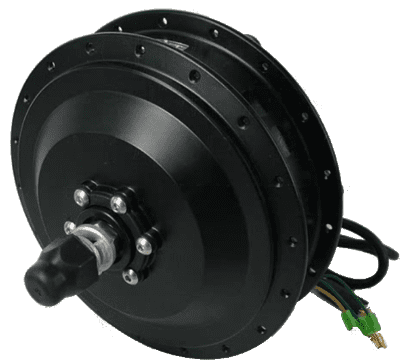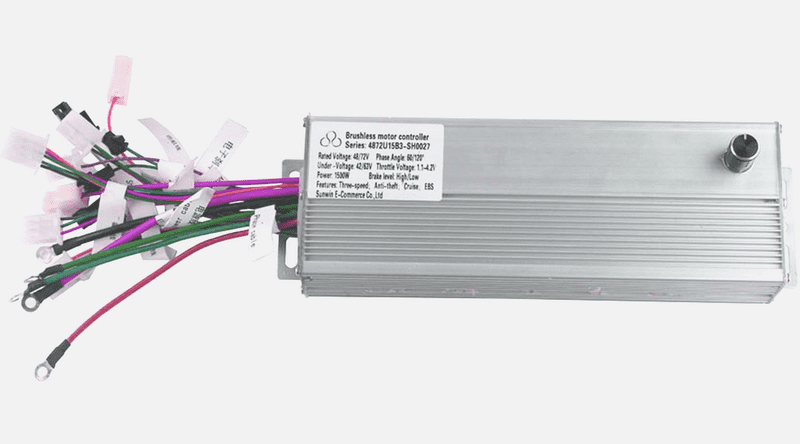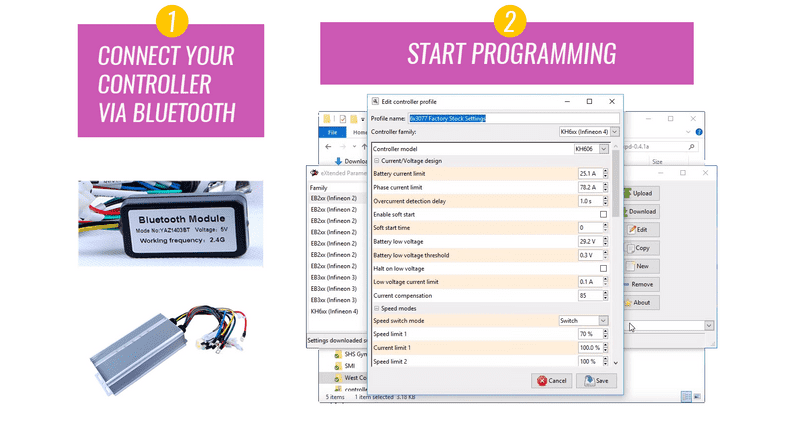Electric Bike Controllers - Which One to Choose?
What is a controller?
A controller is used to connect all electrical components of an e-bike together. Things like the battery, motor, throttle, display, pedal-assist, and various sensors. The controller basically acts as the “heart” for the e-bike.
It takes energy from the battery and directs it to the motor. By twisting the throttle, the user can regulate the power that is being sent to the controller, this, in turn, controls the speed of the e-bike.
As a rule, all controllers have a sealed protective box, as they are placed open on a bicycle, however, some controllers are mounted inside of the frame and hidden away.
Controllers can be divided according to several criteria:
By motor type
Brushless DC motor controllers
Probably the most popular type of motors and controllers among e-bikes is BLDC (Brushless DC Motors). These are the brushless motors with permanent magnets.
They’re quite reliable, have rather high efficiency and relatively simple design. Everything is quite simple with them, manufacturing, operation, service.
Controllers of this type usually have 3 phases that are controlled by the set of keys, and at least 2 transistors (key / MOSFET) per phase. So, it’s 6, 12, 18 keys accordingly (multiple of 6).
Brushed DC motor controllers
Motors of this type have permanent magnets and a collector. Their design is much simpler, in fact, it’s just a set of keys that change the current that is supplied to the engine. Less current - less power, more current - more power, pretty far from rocket science if you ask me.
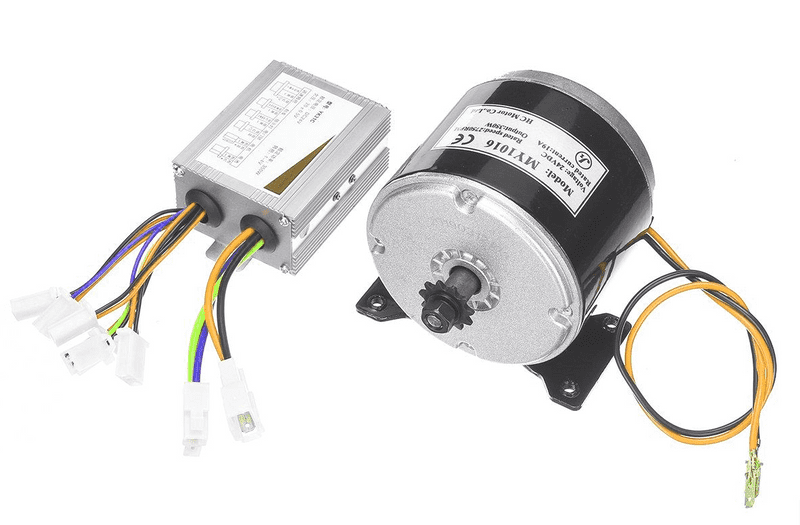
This type of controllers is mostly used on small electric vehicles like scooters, electric bicycles, pedelecs, e-bikes, and other light EV.
Of course, there are other types of controllers, but they are quite rare and mostly used by e-bike enthusiasts and extreme DIY hobbyists. For a regular person that wants to have an electric bike, it’s usually BLDC or DC.
By functionality
As mentioned earlier, DC controllers are usually simple and don’t have a wide range of functions, so, there’s no point in discussing them here. Let’s look more closely at BLDC controllers.
BLDC controllers for motors with Hall sensors
Hall sensors are pretty simple devices that are based on the Hall effect. They determine the position of the rotor relative to the stator. The rotor is the rotating part of the motor and the stator is the fixed part.
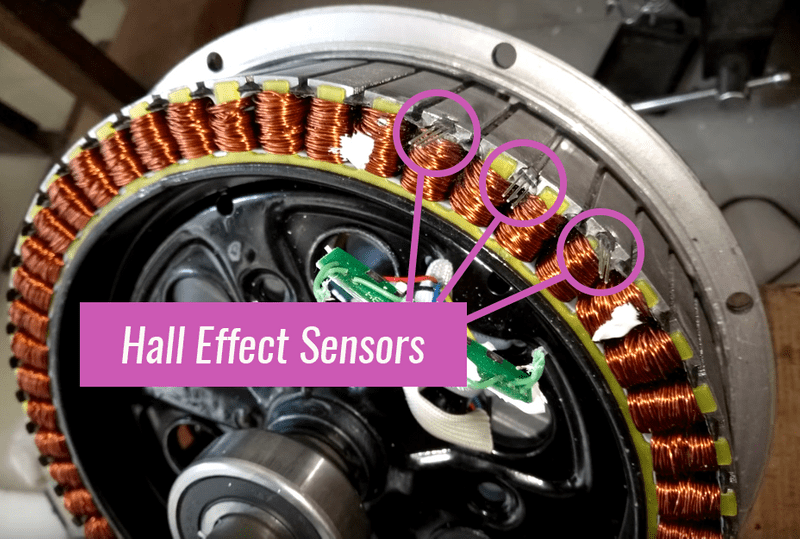
Hall sensors often also called ”rotary encoders”, because they determine the position of the rotor.
Why do we need this? Let’s see. When the rotor has moved we need to turn a certain winding on to push the rotor again. So, the Hall sensor basically determines the exact moment when we need to push the rotor.
Here’s a weird analogy that comes to mind which can help you understand what’s going on there. Imagine that you’re walking past the crowd of people and each one of them pushes you forward. As soon as the next person sees you, they stretch out their hand and push you forward. More or less the same thing is happening in the motor. Sorry for the weird analogy😊.
Also, you may find controllers that can operate both with Hall sensor and without it.
The price
Similarly to every other electronic device on the market, today you can find controllers ranging from very cheap to the most expensive ones.
You can buy a cheap controller at a price of around $20-60. The more expensive ones will cost you anywhere from $200-500.
Usually, cheap controllers don’t have any settings and have minimum connections.
Programmable controllers
Some of the controllers allow changing their settings programmatically. They have the ability to connect to a computer via USB or Bluetooth. Generally, the wired connection is preferred, because it works more reliably and it’s cheaper.
After connecting the device to the computer, we suddenly obtain a whole range of possibilities. For example, we can:
- set a limit on speed
- configure the power limits
- adjust the torque
- enable/disable the pedal-assist
- adjust multiple speeds etc.
- and more…
So, as you can see this type of controllers is perfect for all those passionate e-bike hot rodders out there.
Controller hot rodding
Inevitably, some e-bike enthusiasts decide they want more power and speed out of their motors. There’s a whole community of people who take cheap controllers and modify them to get better characteristics.
You can get a pretty nice performance increase by making small controller modifications.
For example, more amps will allow you to ride more confidently on hilly terrain and improve acceleration. Higher voltage will get you higher top speed and better acceleration in the upper speed range.
However, when doing this, you can get into the situation when the controller will simply blow up, or the motor may become very hot and eventually die. Not a pretty picture right?
But hey, who doesn’t like doing fun experiments, you never know, maybe it’ll still give a decent life after modification.
Some advice on choosing the right controller
It’s worth mentioning that if you’re not an experienced builder and don’t have enough expertise in this area, then it’s better to buy a controller as a part of the kit (controller + motor). In this case, the controller will be matched to the motor and they will work seamlessly together.
Another advice here will be to trust other people’s experiences. If the controller is well made and does not have a large number of registered faults or negative reviews online, then you can safely use it.
Also, if you have friends who are in the bikes repair business, visit them and ask if they had to repair this type of controllers before or if there were any problems with them. This might give you some valuable hints before purchase.
Choosing a controller for a specific motor
If you’re choosing a controller for a specific motor, then check that the controller matches or has even slightly more power than the motor. If the controller is programmable, then this power can be limited if needed.
By doing that, you’ll reduce the heating of the controller and make its operation more stable, which in consequence will increase the reliability of the system.
Important Note: the controller’s voltage rating must match your battery and motor.
If you buy a non-programmable controller, make sure that it’s power and voltage matched with the power and voltage of the motor. If the motor voltage is 36V, then the voltage of the controller should be 36V too.
Phase and battery currents
Here’s another moment that can be confusing for beginners when choosing the controller.
The phase current and the current from the battery should be strictly distinguished. These are two different things. The phase current is connected to the motor and it can be much greater than the battery current.
Take for example a welding machine. It takes 10A from the network and gives all 120A at the output. The controller works by the same principle. It can take 50A from the battery, and give 100A to the motor. Therefore, it’s necessary to distinguish between battery and phase currents.
When choosing a controller for the specific motor, you need to check that the phase current of the controller and the motor current match. Otherwise, when a large current is supplied, the motor will heat up more and more likely to fail.
When the motor overheats, the varnish coating on the wires begins to lose its properties. This creates a short circuit and the motor starts to warm up rapidly and malfunctions.
Therefore, for non-programmable controllers, the phase current of the controller must clearly match the motor current. Then this configuration will be optimal and will not lead to the failure of individual components.
The difference between square and sine wave controllers
Perhaps you’ve seen discussions about square and sine wave controllers. They differ in the phase voltage waveform. The first is rectangular, the second is sinusoidal.
It’s really hard to say which one is better because the optimal waveform depends on the wheel itself, and they’re all quite different. Ideally, this point should be taken into account by the wheel manufacturer, but it’s unlikely that they’ll be doing this.
Can I repair my controller if it broke?
If you have a cheap controller and it’s no longer working, it’s probably easier to buy yourself a new one for about $30 and don’t waste your precious time trying to fix the thing. Or you can use it for spare parts and various experiments.
It just doesn’t make sense to repair it, because they are mass-produced and mostly made disposable.
More expensive controllers such as Kelly are generally more maintainable.
For example, in Kelly’s models, the power unit is galvanically isolated from the control unit. And if the power part breaks, then the micro controller itself remains in working condition. Therefore, in general, this adds some points to the maintainability.
Of course, it all depends on how badly the circuit board was damaged. Sometimes the circuit board is burned really hard, and all the tracks on it melt, in which case it will be too difficult to restore it mechanically.
Final thoughts
At the moment, there are a huge number of controllers of various configurations on the market. When you decided to buy a controller, don’t just order the first one that you saw on the internet, but take your time, carefully consider all the functions that you’ll need.
There’s a chance that you will pay extra money for the features that you’ll never use, or, on the contrary, miss something important, without which you won’t enjoy riding your e-bike. Always consider the following points:
- voltage and power of the motor and battery
- required control functions
- dimensions of the controller
- don’t confuse phase and battery currents
- trust other people’s experience
- consider buying a controller as a part of the conversion kit
Taking into account all these points, you will make a confident choice and will not be disappointed with your purchase.
